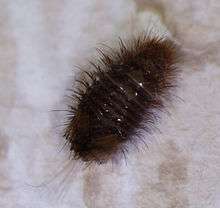Anthrenus museorum
| Museum beetle | |
|---|---|
| | |
| Anthrenus museorum | |
| Scientific classification | |
| Kingdom: | Animalia |
| Phylum: | Arthropoda |
| Class: | Insecta |
| Order: | Coleoptera |
| Family: | Dermestidae |
| Genus: | Anthrenus |
| Subgenus: | Anthrenus (Florilinus) |
| Species: | A. museorum |
| Binomial name | |
| Anthrenus museorum (Linnaeus, 1761) | |
Anthrenus museorum, commonly known as the museum beetle, is a species of beetle found in the Palearctic (including Europe), the Near East and the Nearctic. In its larval form it damages all forms of dry skin and hair. The larva will also eat dry cheese, flour or cocoa occasionally.[1] It is a considered a pest, as it damages, among other, the skin of taxidermy, such as in museums.[2][3]

The larva is yellowish, hairy, and measures 4.5 millimetres (0.18 in). The dorsal surface of the prothorax is brownish. At its rear end, it has three pairs of long antenna. The adult measures 2 to 4 mm. It has a round shape and its dark elytra are spotted with bright colors. It lives for one or two weeks, outdoors, on plants. It prefers the flowers of Asteraceae, Apiaceae and Scrophulariaceae. To lay eggs, the female seeks nooks, carpets, flooring or wool to hide and to assure a food supply for the larvae. She lays forty eggs at a time once a year.[1]
Range
In Europe, it is known from Albania, Austria, Belarus, Belgium, Bosnia and Herzegovina, Bulgaria, Croatia, the Czech Republic, mainland Denmark, Estonia, Finland, mainland France, Germany, Great Britain including the Isle of Man, mainland Greece, Hungary, mainland Italy, Kaliningrad, Latvia, Liechtenstein, Lithuania, Luxembourg, the Republic of Macedonia, Moldova, mainland Norway, Poland, mainland Portugal, Romania, Russia, Sardinia, Slovakia, Slovenia, mainland Spain, Sweden, Switzerland, the Netherlands, Ukraine, Yugoslavia.[4][5]
References
- 1 2 "Anthrène des musées". Archived from the original on unknown. Check date values in:
|archive-date=(help) - ↑ Montagu Browne (31 July 2015). Practical Taxidermy - A Manual of Instruction to the Amateur in Collecting, Preserving, and Setting up Natural History Specimens of All Kinds. To Which is Added a Chapter Upon the Pictorial Arrangement of Museums. Read Books Limited. p. 211. ISBN 978-1-4733-7689-2.
- ↑ Strang, T. J. K. "Session 7: Museum Pests." Available from: http://spiru.cgahr.ksu.edu/proj/iwcspp/pdf2/11/108.pdf
- ↑ "Anthrenus museorum' at Fauna Europaea : Taxon Details". Retrieved 2013-03-18.
- ↑ "Anthrenus museorum at Global Biodiversity Information Facility". Retrieved 2013-03-18.
External links
| Wikimedia Commons has media related to Anthrenus museorum. |
| Wikispecies has information related to: Anthrenus museorum |